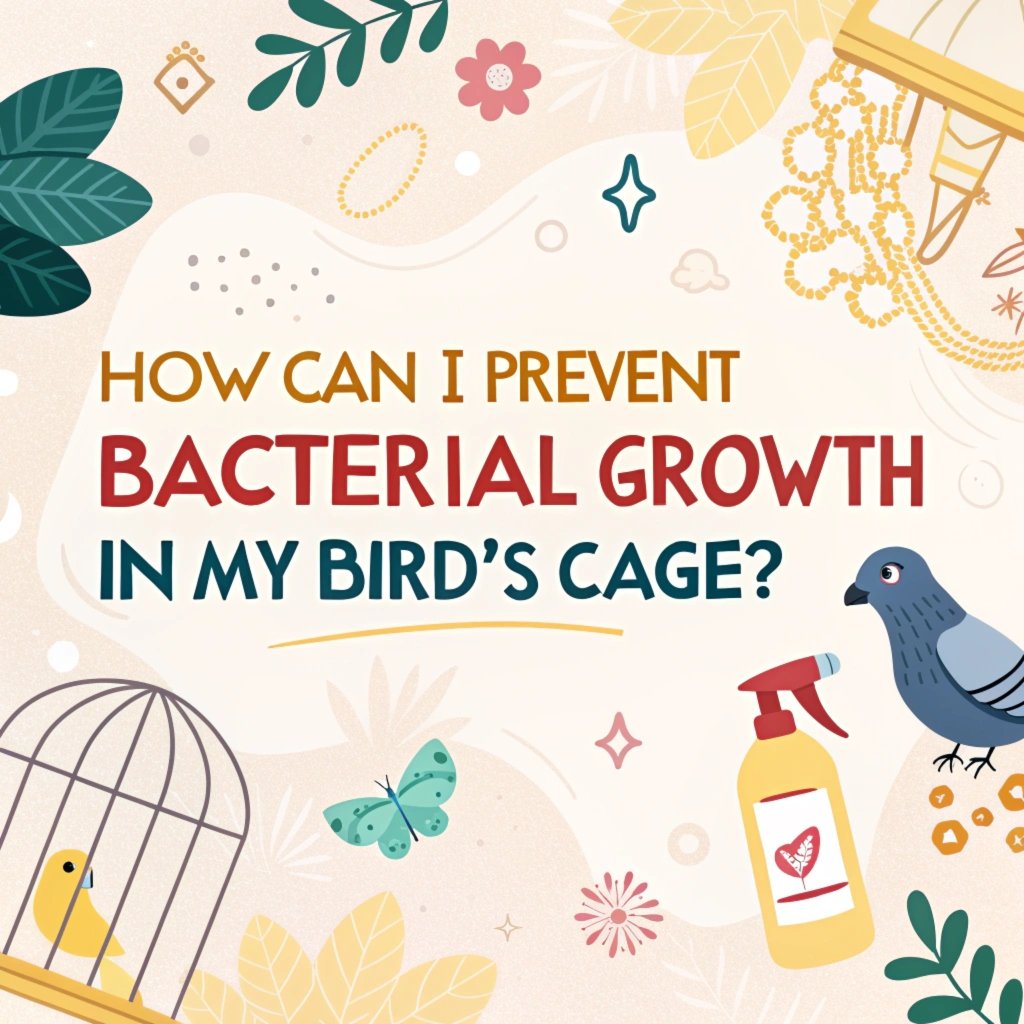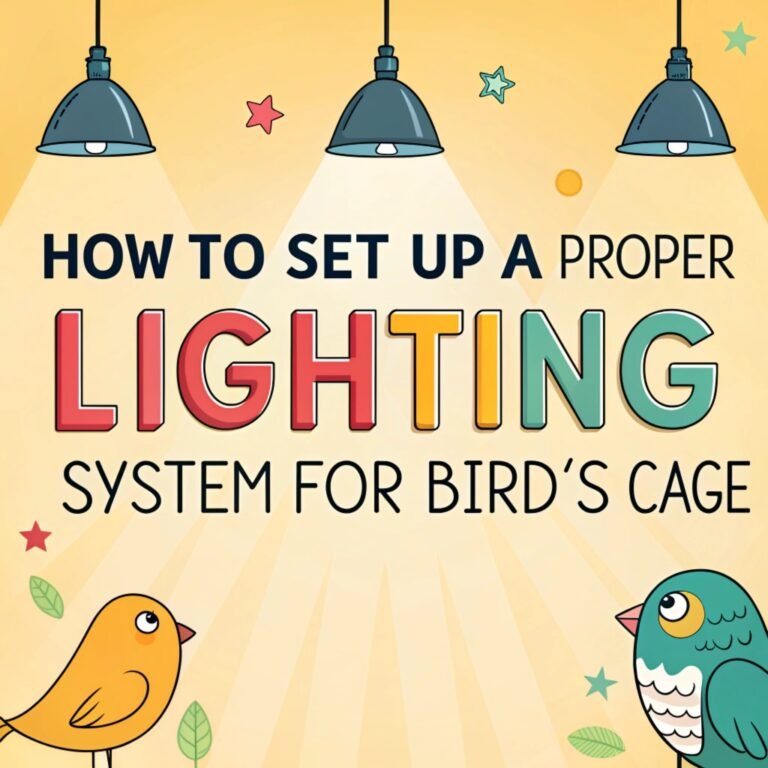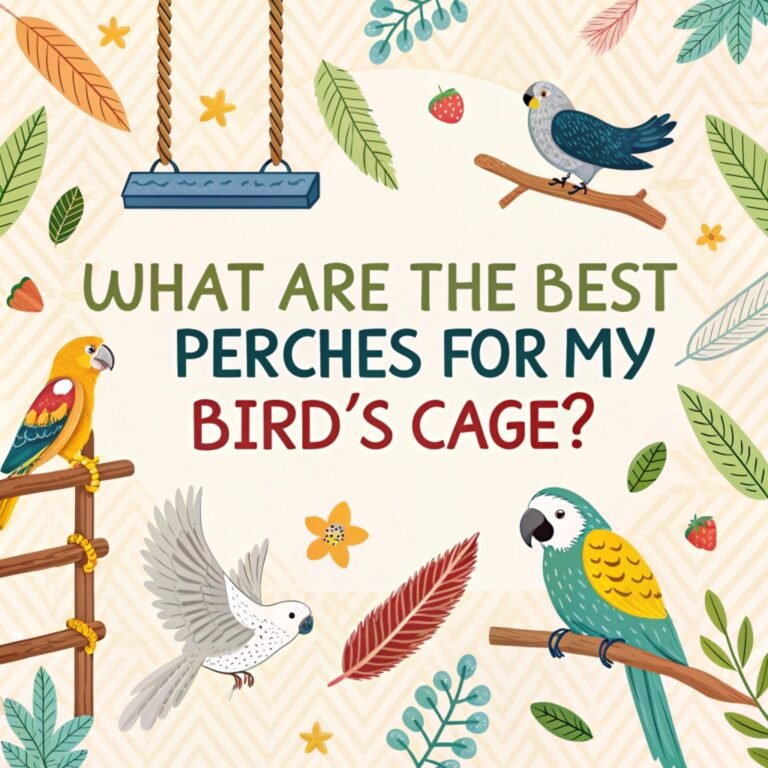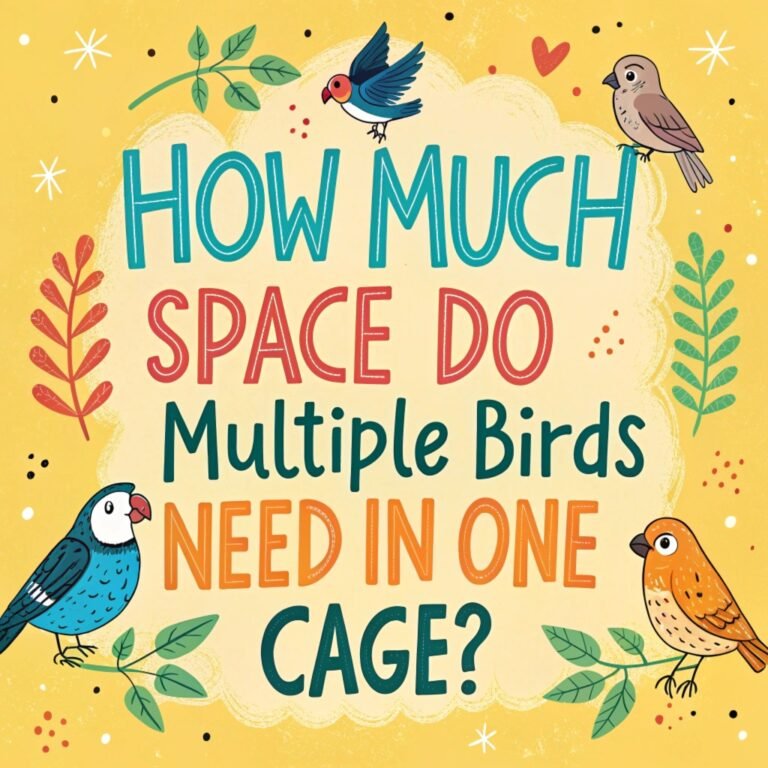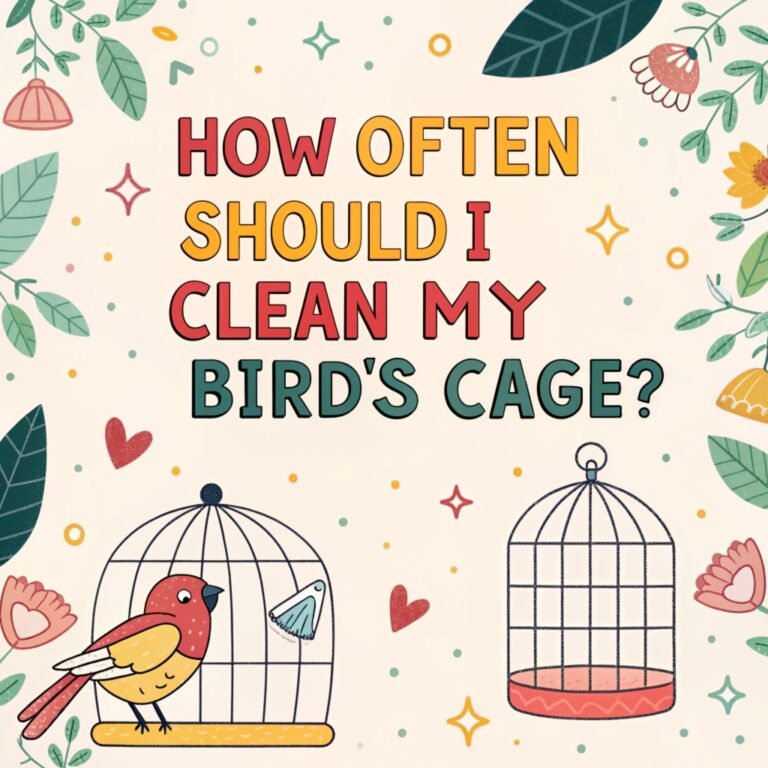How Can I Prevent Bacterial Growth In My Bird’s Cage? Essential Tips for a Clean and Healthy Avian Environment
Bacterial growth in a bird’s cage can lead to various health issues and create an unpleasant living space.
Maintaining a clean and hygienic environment for your feathered friend is crucial for their health and well-being.
By implementing proper cleaning techniques and following a regular maintenance routine, you can significantly reduce the risk of bacterial proliferation and ensure your bird thrives in a safe, healthy habitat.
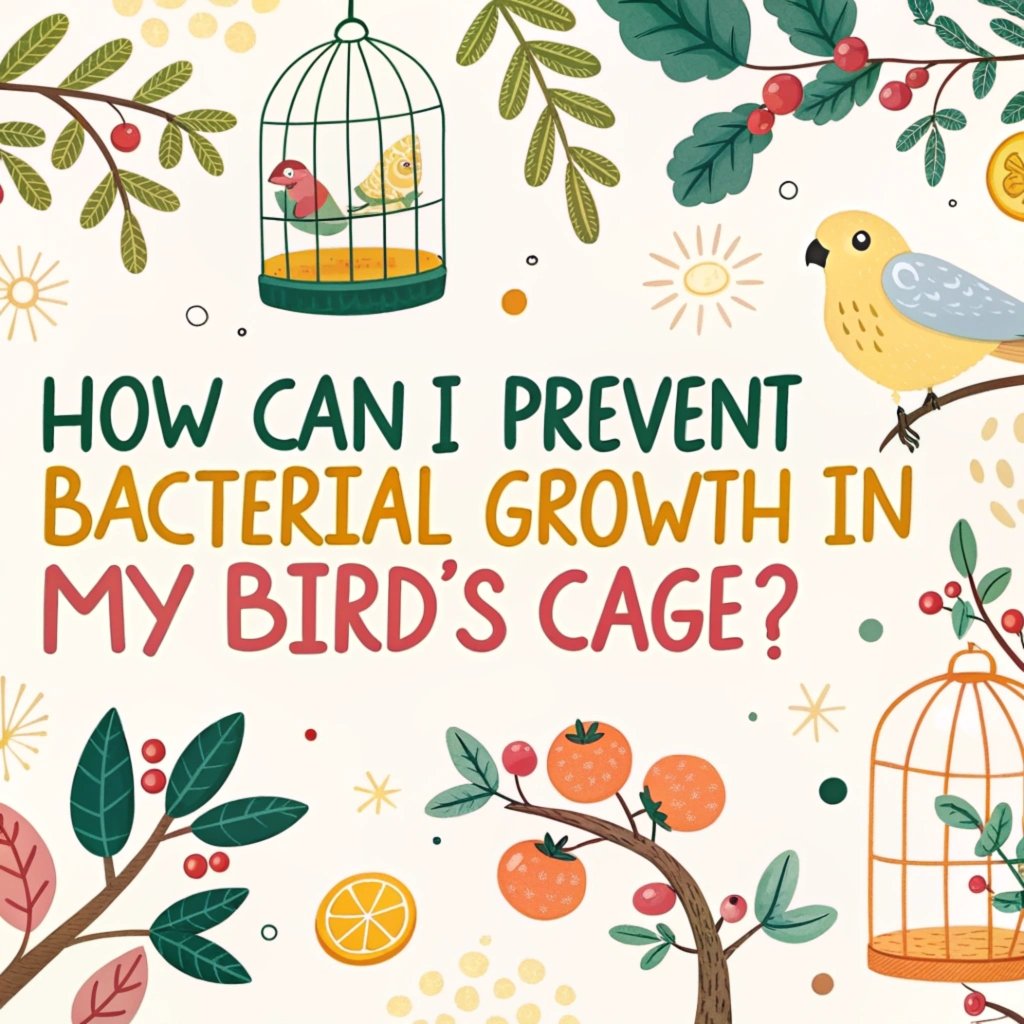
Key Takeaways:
- Daily cleaning is essential to maintain a hygienic environment for your bird
- Use safe, non-toxic cleaning products such as vinegar, baking soda, and lemon juice
- Change cage liners daily to prevent the accumulation of droppings and food debris
- Clean and disinfect food and water dishes every day to prevent bacterial growth
- Regularly clean and replace perches, toys, and accessories to minimize bacterial harboring
- Implement a weekly deep cleaning routine for thorough cage maintenance
- Avoid using harmful chemicals or scented products that can be toxic to birds
- Proper ventilation and air circulation help reduce moisture and bacterial growth
- Monitor your bird’s health closely and consult a veterinarian if you notice any changes
- Quarantine new birds before introducing them to your existing flock to prevent disease spread
- Use bird-safe disinfectants and rinse thoroughly after cleaning
- Maintain proper humidity levels in the bird’s environment to discourage bacterial growth
- Regularly inspect the cage for any signs of mold or mildew
- Provide fresh, clean water daily to prevent bacterial contamination
- Store bird food properly in sealed containers to prevent spoilage and bacterial growth
Daily Cleaning Routine: The Foundation of a Healthy Cage
Establishing a daily cleaning routine is the cornerstone of preventing bacterial growth in your bird’s cage. This practice not only keeps the living space hygienic but also allows you to monitor your bird’s health closely.
Start by removing all food and water dishes and washing them thoroughly with mild, unscented dish soap. Rinse them well and dry completely before refilling and returning them to the cage.
Change the cage liner daily, as this prevents the accumulation of droppings and discarded food, which can quickly become breeding grounds for bacteria.
Use disposable paper or newspaper for easy cleaning and to monitor your bird’s droppings effectively.
Wipe down perches, toys, and cage bars with a bird-safe cleaner or a mixture of water and vinegar to remove any visible debris or droppings.
This daily attention to cleanliness will significantly reduce the risk of bacterial proliferation and create a healthier environment for your feathered companion.
Weekly Deep Cleaning: Thorough Maintenance for Optimal Hygiene
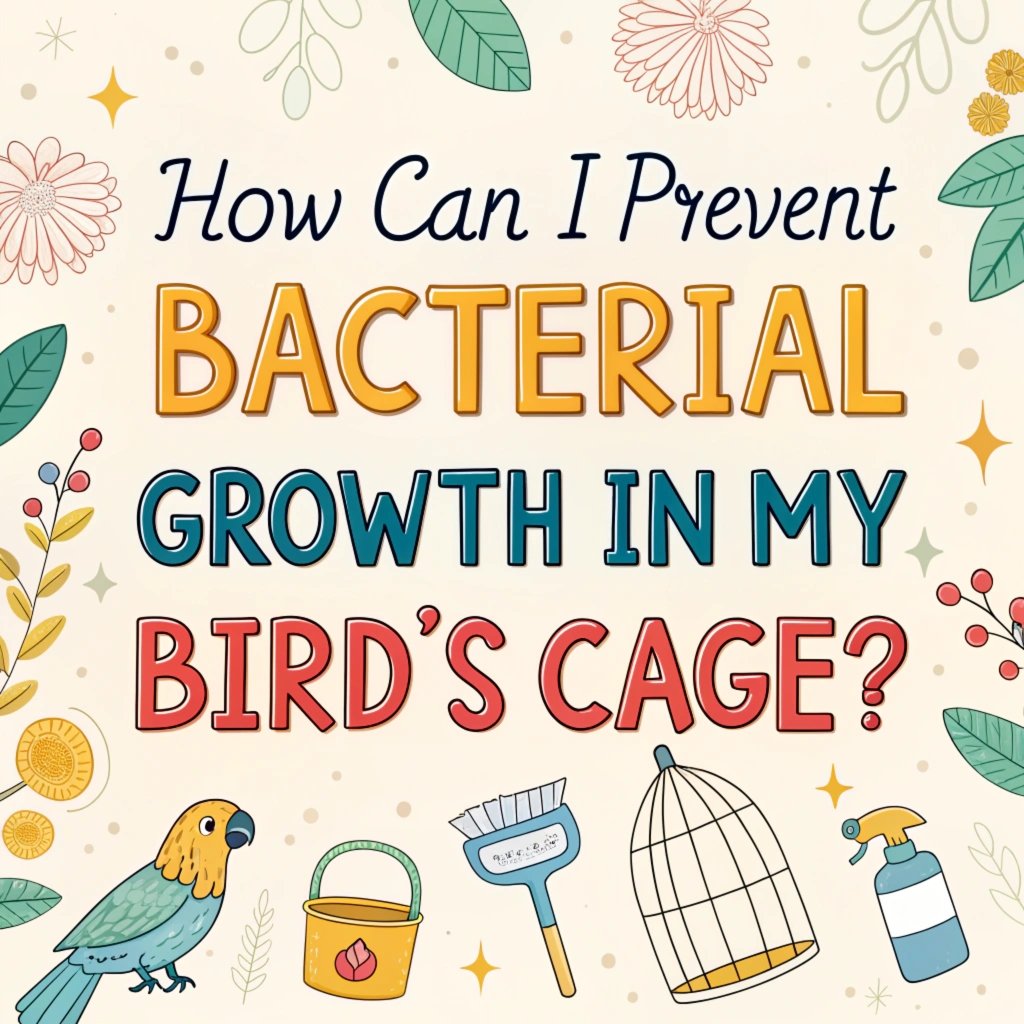
A weekly deep cleaning session is crucial for maintaining optimal hygiene in your bird’s cage. This more intensive cleaning process helps eliminate any hidden bacteria or accumulated grime that daily cleaning might miss.
Start by removing your bird from the cage and placing them in a safe, temporary enclosure. Take out all removable items such as perches, toys, and accessories.
Scrub the cage thoroughly with a mixture of hot water and mild, unscented dish soap, paying special attention to corners, crevices, and welded areas where bacteria can hide.
Use a sturdy brush with durable bristles to ensure effective cleaning. For stubborn stains or dried droppings, a mixture of vinegar and water can be particularly effective.
After cleaning, rinse the cage thoroughly with clean water to remove any soap residue. Allow the cage to air dry completely before reassembling it with clean accessories and returning your bird to their freshly cleaned home.
Safe Cleaning Products: Natural Solutions for a Bird-Friendly Environment
When it comes to cleaning your bird’s cage, choosing safe, non-toxic products is paramount. Many commercial cleaners contain harsh chemicals that can be harmful to your bird’s delicate respiratory system.
Instead, opt for natural cleaning solutions that are both effective and bird-friendly. Vinegar is an excellent choice for cleaning and disinfecting.
Mix equal parts water and white vinegar in a spray bottle for an all-purpose cleaner.
Baking soda is another safe option, particularly effective for eliminating odors and scrubbing away stubborn stains.
Create a paste with water for tougher cleaning jobs. Lemon juice can be used to freshen the cage and cut through grease.
However, use it sparingly as its strong scent might irritate your bird. These natural cleaners not only effectively clean and disinfect but also provide a safer alternative to chemical-based products, ensuring your bird’s environment remains free from harmful toxins while still maintaining a high standard of cleanliness.
Proper Disinfection Techniques: Ensuring a Germ-Free Environment
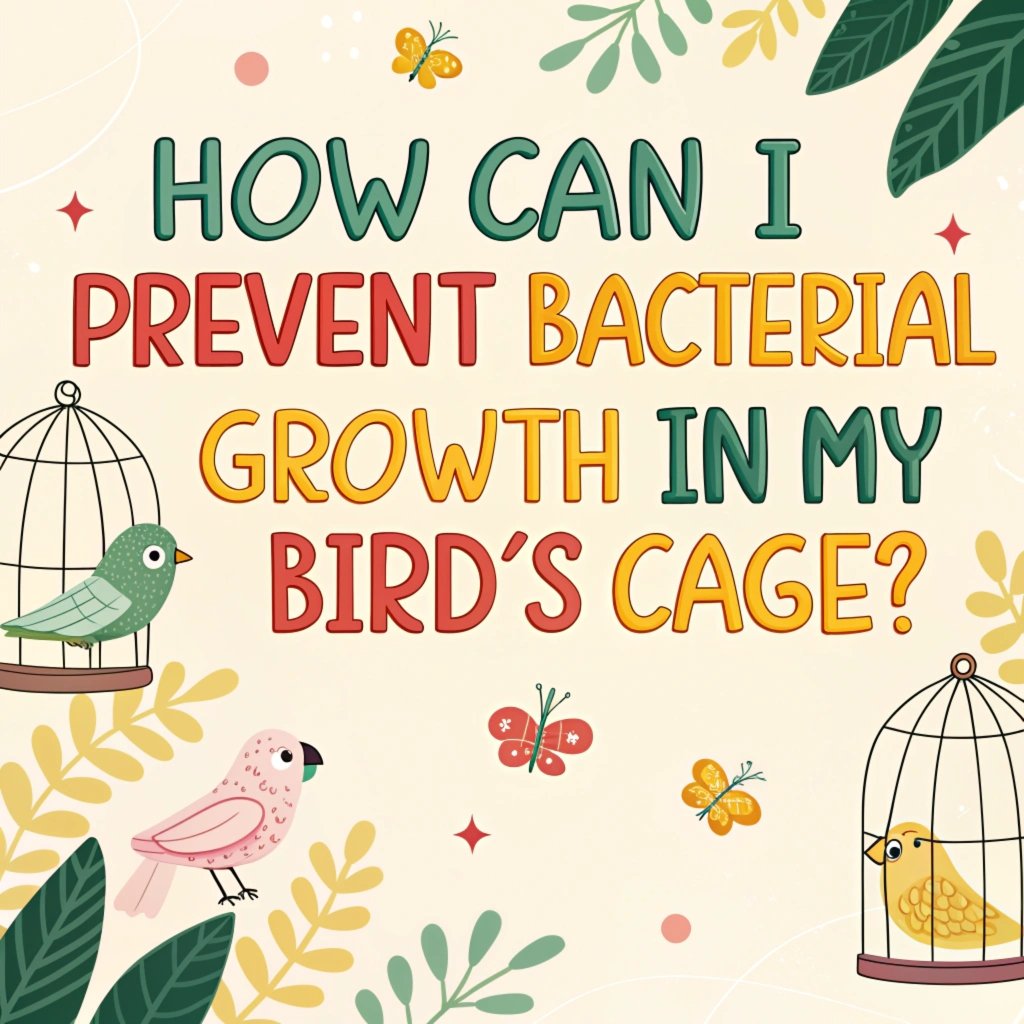
Proper disinfection is crucial in maintaining a germ-free environment for your bird. While cleaning removes visible dirt and debris, disinfection kills harmful microorganisms that can cause disease.
When disinfecting your bird’s cage, it’s important to use bird-safe disinfectants and follow the correct procedures.
A solution of one part bleach to ten parts water can be an effective disinfectant, but ensure your bird is not in the vicinity during application due to fumes.
Alternatively, use commercial avian disinfectants available at pet stores. Always apply disinfectants to a wet surface for maximum effectiveness.
Allow the disinfectant to sit for the recommended time, usually about 10-15 minutes, before thoroughly rinsing with clean water.
Dry all surfaces completely before returning your bird to the cage. Remember, disinfection should be done at least once a week or more frequently if your bird has been ill.
By incorporating proper disinfection into your cleaning routine, you create a safer, healthier environment for your feathered friend.
Food and Water Hygiene: Preventing Contamination at the Source
Maintaining impeccable hygiene for your bird’s food and water is crucial in preventing bacterial growth. Clean and disinfect food and water dishes daily using hot, soapy water, and rinse thoroughly.
Consider using stainless steel or ceramic dishes as they are less porous and easier to clean than plastic ones.
Replace water at least twice a day with fresh, clean water to prevent bacterial buildup. When it comes to food, remove any uneaten fresh foods after a few hours to prevent spoilage and bacterial growth.
Store dry bird food in airtight containers in a cool, dry place to prevent moisture and pests from contaminating it.
If you provide sprouted seeds or other moist foods, prepare them fresh daily and remove any leftovers promptly. Be cautious with fruit and soft foods, as they can quickly become breeding grounds for bacteria in warm environments.
By maintaining strict food and water hygiene, you significantly reduce the risk of bacterial contamination, ensuring your bird’s diet remains safe and healthy.
Perch and Toy Maintenance: Keeping Play Areas Clean and Safe
Regular cleaning and maintenance of perches and toys is essential in preventing bacterial growth in your bird’s cage.
Wooden perches can harbor bacteria in their porous surface, so clean them weekly with a mild soap solution and allow them to dry completely before returning them to the cage.
Consider rotating perches to allow for thorough drying and to prevent excessive wear. For plastic or metal perches, wipe them down daily and disinfect weekly.
Inspect toys regularly for signs of wear, fraying, or accumulated dirt. Clean hard plastic toys with a mild soap solution, while fabric or rope toys may need to be replaced more frequently as they are difficult to clean thoroughly.
Rotate toys weekly to maintain your bird’s interest and allow for proper cleaning. Remember to rinse all items thoroughly after cleaning to remove any soap residue.
By keeping perches and toys clean and well-maintained, you not only prevent bacterial growth but also ensure your bird’s play areas remain safe and engaging.
Ventilation and Air Quality: Creating a Healthy Atmosphere
Proper ventilation and air quality play a crucial role in preventing bacterial growth in your bird’s cage. Good air circulation helps to reduce humidity and disperse airborne particles, both of which can contribute to bacterial proliferation.
Ensure your bird’s cage is placed in a well-ventilated area, away from drafts but with sufficient air movement. Avoid placing the cage in damp areas or near kitchens or bathrooms where humidity levels can be high.
Consider using an air purifier with a HEPA filter to remove dust, dander, and other airborne particles that can accumulate in the cage.
Regularly dust and vacuum the area around the cage to minimize airborne contaminants. If you live in a humid climate, a dehumidifier can help maintain optimal humidity levels, typically between 40-50% for most bird species.
By maintaining good air quality and ventilation, you create an environment that is less conducive to bacterial growth, promoting better respiratory health for your feathered friend.
Cage Material Considerations: Choosing Easy-to-Clean Options
The material of your bird’s cage can significantly impact your ability to maintain a clean, bacteria-free environment.
Stainless steel cages are often the best choice as they are durable, non-porous, and easy to clean and disinfect.
They resist rust and don’t absorb bacteria or odors. Powder-coated metal cages are also a good option, but ensure the coating is non-toxic and chip-resistant.
Avoid wooden cages as they are porous and can harbor bacteria, making them difficult to clean thoroughly. If you have a plastic cage, inspect it regularly for scratches or cracks where bacteria can hide.
When selecting a cage, look for one with a removable bottom tray for easy cleaning. Smooth surfaces are preferable to textured ones as they are easier to clean and less likely to trap debris.
Consider the spacing between bars to ensure easy access for cleaning while preventing your bird from escaping.
By choosing the right cage material, you can make your cleaning routine more effective and efficient, helping to maintain a hygienic environment for your bird.
Quarantine Procedures: Protecting Your Flock from New Arrivals
Implementing proper quarantine procedures is essential when introducing new birds to your existing flock to prevent the spread of bacteria and diseases.
Quarantine new birds for at least 30 days, preferably in a separate room or building. During this period, observe the new bird closely for any signs of illness, such as lethargy, loss of appetite, or abnormal droppings.
Clean and disinfect the quarantine area daily, using separate cleaning tools from those used for your existing birds.
Wash your hands thoroughly and change clothes between handling quarantined birds and your established flock. Consider having a veterinary check-up for the new bird during the quarantine period to ensure they are healthy before introduction.
If possible, perform routine health tests such as fecal exams or blood work to check for common avian diseases.
By following strict quarantine procedures, you significantly reduce the risk of introducing harmful bacteria or pathogens to your existing birds, maintaining the health and safety of your entire avian family.
Monitoring Bird Health: Early Detection of Bacterial Issues
Regular health monitoring is crucial in detecting and preventing bacterial issues in your bird. Observe your bird daily for any changes in behavior, appetite, or droppings. Healthy droppings should be firm and well-formed, with a white cap of urates.
Watery, discolored, or foul-smelling droppings can indicate bacterial infections. Watch for signs of lethargy, fluffed feathers, or decreased activity, which can be early indicators of illness.
Check your bird’s beak, nares (nostrils), and feet regularly for any abnormalities or discharge. Monitor food and water intake to ensure your bird is eating and drinking normally.
Weigh your bird weekly using a gram scale to detect any subtle weight changes that might indicate health issues.
Keep a health journal to track any observations or concerns. If you notice any unusual symptoms or behaviors, consult an avian veterinarian promptly.
Early detection and treatment of bacterial infections can significantly improve outcomes and prevent the spread of illness to other birds in your care.
Humidity Control: Balancing Moisture Levels for Optimal Health
Maintaining proper humidity levels is essential in preventing bacterial growth in your bird’s environment. Most bird species thrive in environments with relative humidity between 40-50%.
Excessive humidity can create a breeding ground for bacteria and mold, while too little moisture can lead to respiratory issues. Use a hygrometer to monitor humidity levels in your bird’s room.
In humid climates, consider using a dehumidifier to reduce moisture in the air. Conversely, in dry environments, a humidifier may be necessary to maintain adequate moisture levels.
Avoid misting your bird or their cage in humid conditions, as this can promote bacterial growth. Instead, provide a shallow bath dish for your bird to bathe in as needed.
Clean and dry the bath dish thoroughly after each use to prevent bacterial accumulation. Ensure good air circulation in the room to help regulate humidity levels.
By maintaining optimal humidity, you create an environment that is less conducive to bacterial growth while supporting your bird’s respiratory health and overall well-being.
Proper Food Storage: Preventing Spoilage and Contamination
Proper food storage is crucial in preventing bacterial growth and ensuring your bird’s diet remains safe and nutritious. Store dry bird food in airtight containers in a cool, dry place, away from direct sunlight.
This prevents moisture and pests from contaminating the food. Check expiration dates regularly and discard any expired food.
For fresh fruits and vegetables, wash them thoroughly before offering them to your bird, and store them in the refrigerator until use.
Prepare only small amounts of fresh food at a time to prevent spoilage. If you offer sprouted seeds, prepare them fresh daily and discard any unused portions. Avoid leaving fresh foods in the cage for extended periods, especially in warm weather.
Clean food dishes thoroughly after each use to prevent bacterial buildup. If you use vitamin or mineral supplements, store them according to the manufacturer’s instructions, typically in a cool, dry place.
By implementing proper food storage practices, you significantly reduce the risk of bacterial contamination in your bird’s diet, promoting better health and reducing the likelihood of foodborne illnesses.
Cleaning Tools and Supplies: Maintaining Hygienic Equipment
The cleanliness of your cleaning tools and supplies is just as important as the cleanliness of the cage itself in preventing bacterial growth.
Designate specific cleaning tools for your bird’s cage and accessories to avoid cross-contamination with other household cleaning. Clean and disinfect brushes, sponges, and cloths after each use.
Consider using disposable paper towels for daily cleaning to minimize the risk of spreading bacteria. Store cleaning supplies in a clean, dry area away from your bird’s living space.
Replace sponges and scrub brushes regularly, as these can harbor bacteria over time. If you use a vacuum cleaner for cleaning around the cage area, ensure it has a HEPA filter to trap fine particles and dander.
Wash your hands thoroughly before and after cleaning your bird’s cage to prevent the spread of bacteria.
By maintaining clean and hygienic cleaning tools, you ensure that your efforts to keep your bird’s environment clean are not undermined by contaminated equipment.
Regular Veterinary Check-ups: Professional Health Assessments
Regular veterinary check-ups are an essential component in preventing and detecting bacterial issues in your bird. Schedule annual wellness exams with an avian veterinarian, even if your bird appears healthy.
These check-ups allow for early detection of potential health problems, including bacterial infections.
During these visits, the veterinarian will perform a physical examination, assess your bird’s weight and overall condition, and may recommend routine health screenings such as blood tests or fecal examinations.
These tests can detect subclinical infections or imbalances before they become serious health issues.
Your veterinarian can also provide guidance on proper cage hygiene and nutrition tailored to your bird’s specific needs.
If you notice any changes in your bird’s behavior or health between check-ups, don’t hesitate to consult your veterinarian promptly.
By maintaining a relationship with an avian veterinarian and adhering to regular check-ups, you ensure that your bird receives comprehensive care and that any potential bacterial issues are addressed swiftly and effectively.
FAQs
How often should I clean my bird’s cage?
You should perform a daily cleaning of your bird’s cage, which includes changing the liner, cleaning food and water dishes, and wiping down perches and toys. A more thorough cleaning should be done weekly, involving disassembling the cage and cleaning all components.
What are safe disinfectants to use in a bird cage?
Safe disinfectants include a diluted bleach solution (1 part bleach to 10 parts water), vinegar, or commercial avian disinfectants. Always rinse thoroughly after using any disinfectant and ensure

Hello, I’m Amelia White, the founder of birdsfanatic.com. As a lifelong bird enthusiast and spiritual seeker, I’ve always been fascinated by the mystical connections between birds and the human experience. On this site, I share my knowledge and insights into the symbolic meanings and spiritual significance of various bird species, exploring their roles in mythology, folklore, and cultural traditions. Join me on this journey into the world of birds, where we’ll discover the hidden wisdom and guidance that these magnificent creatures have to offer.

